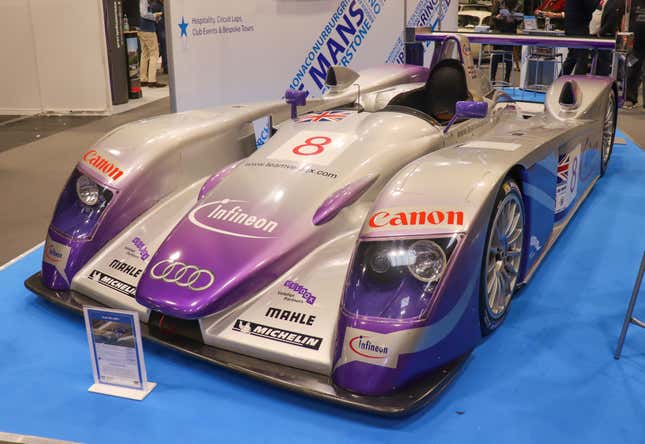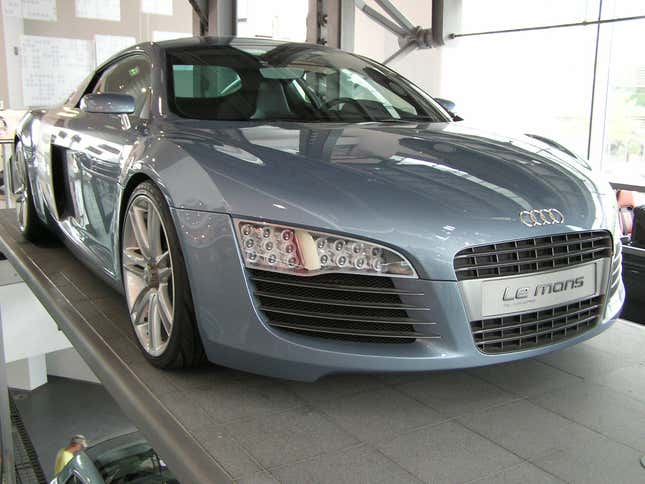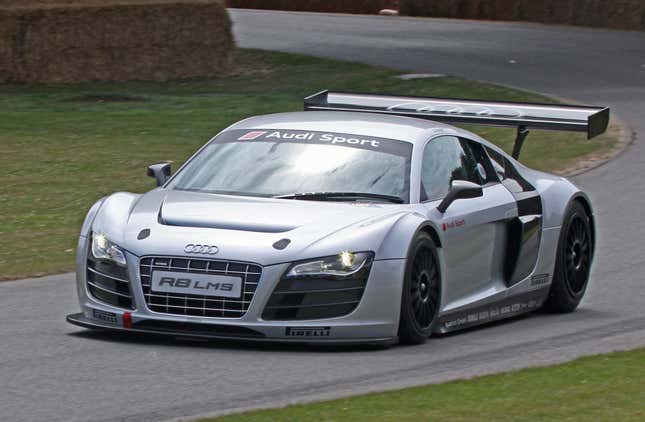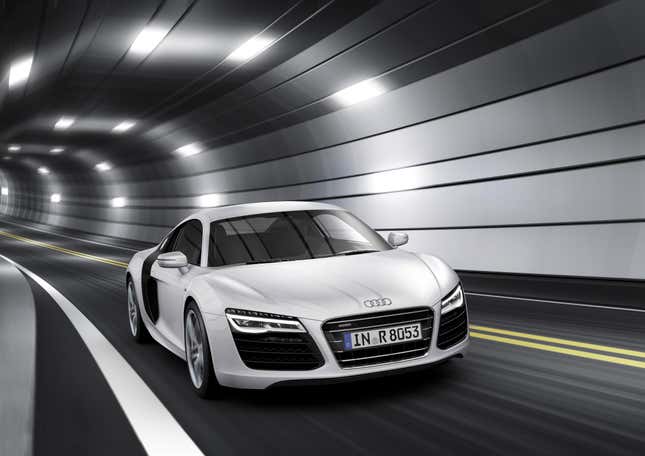The Audi R8 Was A Legend From The Start

Legends don’t die, especially automotive ones; they live on under plaques at car shows, in cheap posters stuck to childhood bedroom walls and in matchbox car collections forever. The Audi R8 is about to lay down its nameplate some twenty years after it first showed its face as a concept car at the 2003 Frankfurt Motor Show. Audi invited us out to Monterey Car Week for a proper high-speed send off of its famous mid-engine sports car at Weathertech Raceway Laguna Seca.
(Audi brought me out to Monterey, California, for Monterey Car Week and provided journalists with transportation around town, meals, and a gased-up, rear-wheel-drive Audi R8 V10 at Laguna Seca.)
After all of the historic racers had made their way around the track, we happy few were ushered towards a pair of Audi R8 V10s, one in rear-wheel drive and the other a Quattro. I can now say I had the privilege of piloting a rear-wheel drive Audi R8 around the historic circuit.
We didn’t much time with the track to ourselves, so it wasn’t really about getting a feel for the car and all it can do. But the R8 was a car even normal, non car people know about and admire. It was a true legend, one I’d previously only ever been able to ride along in one back when I started in automotive journalism in 2013. This time, journalists barely had a moment to adjust their seat before they hit that hallowed pavement. Despite the best coaching efforts of nine-time Le Mans winner Tom Kristensen, none of us set any speed records that day. You can see a track a million times, drive it in video games or even be on the grounds for hours, but it’s an entirely different kettle of fish when actually driving the track.
While our two laps were too short—over in the blink of an eye really—I still got to bask in the glow of automotive history, which happens to be my favorite subject of all time. Between teasing me over the hot pink sunburn I acquired at The Quail and sharing our love of the Karmann Ghia, R8 designer Frank Lamberty couldn’t help but beam with pride as we sat trackside at Laguna Seca. He repeated a line delivered to him by Audi’s famous design boss Walter de Silva.
“We have to design, not a British mid-engine sports car, not an Italian mid-engine sports car, but a German mid-engine sports car. And I said, OK, that’s a cool message but what does that mean? Ah, we had to find our own identity.”
The Audi R8 started life in motorsport, with the Audi R8R prototype proceeding the R8 LMP, which would take 24 Hours of Le Mans by storm, winning from 2000 to 2005 — except in 2003 when the race was won by the Bentley Speed 8.
After its success in racing, Audi had its designers compete to create a road car based on the LMP. The deadline was aggressive. Work started in November 2002 on a show car that would be unveiled at the the 2003 Frankfurt Auto Show held in early September.

Lamberty described his own formula for the Audi R8 during a presentation to journalists; you simply take a Porsche 904, a Ducati 996, a predatory hawk and a…tennis ball. Mush them together and boom, one of the most iconic sports cars of the last two decades. The Porsche 904 is at least as surprising as the tennis ball as it is not considered a terribly successful car, but Lamberty loved its shape as well as its versatility. The 904 was a daily drivable mid-engined car after all; exactly what Audi wanted in the R8.
The tennis ball informed Lamberty’s initial approach to the design; pulling the shape of the R8 out of a sphere rather than a box. That the hawk inspired the side blades also surprised me. To me, the R8’s side blades made it look like the gills of some quick and silent shark ready to strike from the murky depths.
One feverish design competition later and Lamberty’s Audi Le Mans Quattro Concept came out the winner. It was the third in series of race-inspired show cars, but the prospect of this one going into production was much more solid, thanks Volkswagen’s semi-recent acquisition of Lamborghini in 1998.
“That was the puzzle pieces that finally fit together,” Lamberty told Jalopnik.
Like so many of us, the Lamborghini Countach was Lamberty’s childhood hero car. So it’s fitting that Lamberty would realize that German identity de Silva was searching for thanks the Italian automaker. The R8 found a platform and engine companion in the Lamborghini Gallardo.

A few years later in 2006 and a much more production-ready R8 showed its face at the Paris Motor Show. This would be the first generation, the one that Tony Stark tools around in 2008’s Iron Man. It was also the first production car to offer LED lighting as an option for buyers.

Production began in 2007 for the 2008 model year and would carry over many of the design cues of the Audi Le Mans quattro concept, though with simplified laser headlights. In its first generation, it was offered with Audi’s excellent 4.2 Liter V8 behind the passenger compartment with the 5.2 Liter V10 following shortly. It had a supercar heart with sharp, understated styling. But just because the R8 was officially domesticated, doesn’t mean it stopped snagging victories at raceways. Launched at Daytona in 2009, an R8 GT3 racer debuted sharing 50 percent of its parts with the R8 road car, including the engine and space frame originally used in the Gallardo. The race car and road car even run down the exact same line at the factory Neckarsulm in Germany.

The second generation R8 was instilled with the spirit of a different Lamborghini—the Huracan— for its 2015 refresh. The current and final R8 still shares 60 percent of its DNA with the Huracan. This was also the R8 that did away with the V8 option, only offering buyers the symphonic wail of the V10. Those subdued looks and supercar bona fides allowed Audi to move more than 1,000 R8s every month for the last 16 years, according to Good Car Bad Car.

Second Generation Audi R8 – 2015Image: Audi
The R8 is a dream car. It may now seem a little archaic, but it maintains a level of undeniable coolness that will never fade. It’s a true classic, one that doesn’t need to extend its life into multiple decades to make its mark on the automotive landscape. Two laps were certainly not enough to understand the R8, but it was plenty to fall in love with the car.
So, what’s next for Audi? The same song every automaker is singing these days; electrification, digitalization, and automation. But just like this sports car, Audi is sure to bring a purely German take to a world full of green, but hopefully, not boring, cars.
Goodbye, Audi R8, we hardly knew you.



